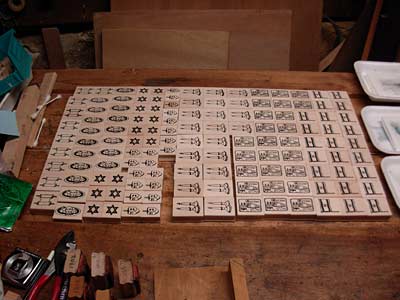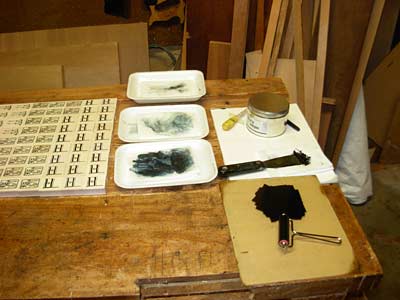I think I’ve talked before about indexing stamps. The batch I did last night was so big I couldn’t resist taking a picture. It was only seven designs, but they’re big sellers, so I did quantity 25 of a couple of them

Here’s the setup. I use a soy oil-based printer’s ink, something like Hi-Tech Tack 12 Intense Black from Great Western Ink in Portland, OR. That’s a one pound can of it towards the right rear. To the left of the can of ink is a medicine dropper which I use to spread a thick orange oil cleaner on two Bounty paper towels each folded in half and then in thirds on its own styrofoam meat tray. I use a lot of cleaner on the front towel and just a little on the second one. There’s a dry third towel on another tray in the back. Then there’s a putty knife for getting the ink out of the can; a palette knife would work. I roll out the ink on a piece of plexiglas with a small Abig brayer and ink my indexing stamp on the brayer.

I put the clean stamp mount in an L-shaped wooden jig, just a corner that has two sides about one and a half times as high as a stamp mount. I hold the clean mount tightly in the corner, line up the inked indexing stamp against the corner, and press down. The jig lets me get the image in the same place on every mount. If the image isn’t fully printed, I can re-ink the indexing stamp and stamp again in exactly the same place (at least a lot of the time). When I’ve done all the mounts of one design, I rub the indexing stamp on the nearest paper towel to get off most of the ink, on the middle one to get rid of almost all the ink, and on the last one to get rid of the last of the ink and the extra cleaning solution. When I’m done, I can often clean off the brayer and plexi with the near towel.
When I first started using the oil based ink, I thought cleaning up from it was a big nuisance. If I’m only doing two stamp designs, cleanup is still a big fraction of the time I’m working, but by now it’s down to a system.